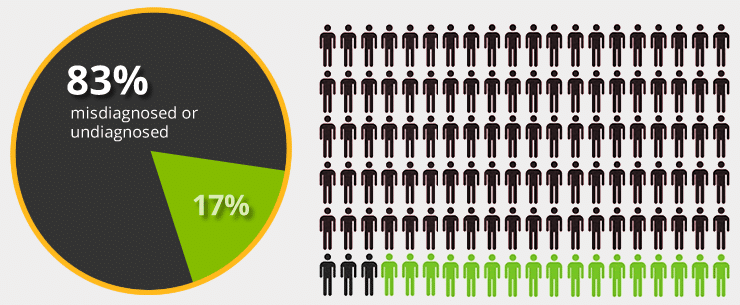Recent studies show that Celiac Disease is four times more prevalent nowadays than it was in the 1950’s. This condition is characterized by an intense immune reaction to gluten which damages villi in the small intestines, some common sources of the compound include wheat, rye and barley. It now affects approximately 1 in every 100 people.
In the research, preserved blood samples taken from healthy male subjects between 1950 and 1954 were scientifically tested for celiac antibodies. Experts also investigated samples collected from other men in the mid-2000s. Age limits for both these two groups were the same.
Celiac Disease Statistics – Findings
They discovered that young people nowadays are 4 1/2 times more prone to this condition than their counterparts who lived in the 1950s. These statistics apply not just for youngsters but older men as well, who suffer even greater risk than those who were born recently. Moreover, undiagnosed patients have a fourfold higher prevalence of death if the disease is left untreated for extended periods. In 2003, another test found that this disease was being diagnosed at a rate 9 times higher than was the case a decade earlier.
From these celiac disease statistics, it’s evident that the condition is no longer rare but actually gaining prominence with time. Doctors believe something has been altered in our modern day society, which makes it more prevalent than in the past. People are encouraged to undergo continuous testing to identify symptoms early, similar to what is usually done with blood pressure and cholesterol.
There’s also need for increased awareness both among the general public and physicians. Sometimes symptoms can be variable and mistaken for other similar conditions such as irritable bowel disorder. Studies suggest that for every individual who has been diagnosed with celiac, there are at least 30 more who suffer from the condition but don’t know about it. Considering that there’s a four times likelihood of mortality from this disease when not detected early, getting more people to be aware of the symptoms is important for general public health safety.
Celiac Disease Quick Facts
It can affect men and women alike despite any age or race differences, however those of Eastern European decent show more disposition due to genetic factors. Around 83% of patients living in the US are either undiagnosed or misdiagnosed. Moreover, 5-20 % who suffer from the disease also have a 1st degree relative with celiac. It could be a parent, siblings or their own children.

Diagnosis is not a one-off thing and according to some doctors the process can even take as much as 6-10 years. This malady has also been linked to other equally perilous disorders like reduced bone mass, neurological problems, infertility, autoimmune conditions and certain strains of cancer. Currently, there are no pharmaceutical remedies available with the only possible way of healing being to avoid foods which contain gluten.
Nevertheless, there’s more reason to be happy given that the sale of gluten-free products has been on the increase lately, with figures expected to reach more than 5 billion dollars by end of 2015. Similarly, diagnosis rates have been rising because of public awareness campaign conducted by concerned individuals. Official figures for those who are aware of the condition is estimated to reach anywhere between 50 and 60% by 2020. A conscious attitude towards food intake can help you and your family members avoid contracting celiac disease.
Scientists also discovered that 60% of kids and 41% of adult patients diagnosed during research were asymptomatic, meaning they didn’t display any symptoms at all. Moreover, 20% of patients with +VE anti-endomysial blood antibody test could not get a biopsy due to varied reasons, such as the insurer refusing to pay for it or the physician not being in a position to conduct this particular procedure.
Only 35% of recently diagnosed individuals suffered from terminal diarrhea, hence dispelling the myth that diarrhea must always be there before a proper diagnosis is made.
There are about 3 million Americans currently living with the disease, a figure that’s roughly equivalent to the entire population of Nevada State.
Since it takes considerably long before a symptomatic individual is identified as having the condition, this may sometimes trigger other disorders such as autoimmune dysfunction, osteoporosis, neurological problems and even tumors. A study done by Ventura, et.al in 1999 showed that toddler patients aged between 2 and 4 yrs old had 10% more chances of developing autoimmune complications.
Also, it has been found that Type I Diabetes affects 6% of patients who have this condition. Similarly, around 610,000 females in America experience infertility with 36,500 of them never learning that their predicament was actually caused by celiac disease.
Facts About Gluten-Free Diet
In the year 2004, a law popularly known as the Food Allergen Labeling and Consumer Protection Act was passed. It allows consumers to check whether the product they are buying contains this compound or not, so as to make a better decision for their overall health. There are well over 2,000 gluten-free foods currently available in the US, and most of them can be found in ordinary grocery stores.
Performing Follow-Up Tests
Laboratory exams should be performed 3 to 6 months following the official diagnosis report, and then yearly for the patient’s entire lifetime. Taking into consideration that those suffering from this condition have damaged villi, it’s likely that they will also have deficiencies in vitamins and essential nutrients.
Regular blood test monitoring can help answer a few pertinent questions, such as whether the small intestines are healing including other related diseases. Generally, one will get to know whether they are improving with the newly adopted gluten-free diet, and at what rate this is happening.
Adult patients should undergo a thorough bone mineral density MRI scan within the 1st year after diagnosis is made. Specific tests will vary depending on the person’s unique situation and doctor’s discretion. Though these exams can be helpful to some large extent, visiting a certified dietitian knowledgeable in gluten-free diet is also recommendable for understanding the celiac disease better. Apart from the above factors, tests can also be helpful in managing lipid, electrolyte and renal profiles of the patient. If you have this disorder then a fruit diet can help induce healing.
